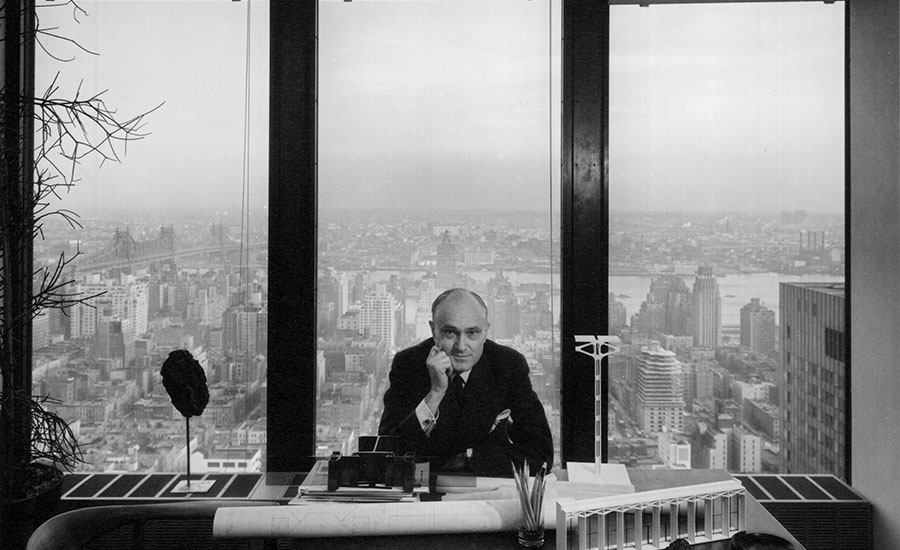Editor's Note: This story was updated on Monday, December 7.
The Museum of Modern Art (MoMA) and Harvard’s Graduate School of Design (GSD) have responded to a November 27th letter demanding that they remove Philip Johnson’s name from every “leadership title, public space or honorific” at those institutions because of his racist and white supremacist activities. The letter also calls on members of MoMA and alumni of the GSD to “refrain from supporting either institution until Johnson’s name is struck from all spaces and titles.”
Johnson, who died in 2005, joined MoMA in 1932 as its founding curator of architecture and design, but left two years later, when he began disseminating Nazi propaganda and attempted to launch a Fascist party in Louisiana. He attended the GSD in the 1940s. The letter, signed by more than 30 architects, artists, and academics, comes at the end of a year in which activists have demanded that institutions grapple with their racist pasts. And it comes in advance of a MoMA exhibition titled “Reconstructions: Architecture and Blackness in America,” scheduled to open on February 20. Of the 10 designers with work in the show, which examines, according to the museum, “urban spaces as sites of resistance and refusal,” eight signed the letter: Emanuel Admassu, Sekou Cooke, J. Yolande Daniels, Felecia Davis, Olalekan Jeyifous, V. Mitch McEwen, Germane Barnes, and Amanda Williams. Two—Walter Hood and Mario Gooden—did not.

The letter was posted by an organization called the Johnson Study Group, which was founded in part by McEwen, a Princeton architecture professor, as she worked on her contribution to the upcoming MoMA exhibition. “Philip Johnson’s widely documented white supremacist views and activities make him an inappropriate namesake within any education or cultural institution that purports to serve a wide public,” the letter says. While there is “a role for Johnson’s architectural work in archives and historic preservation,” it adds, he should not be held up as a role model.
At the end of last week, MoMA's Philip Johnson Chief Curator of Architecture and Design, Martino Stierli, wrote to RECORD: “The Museum and I are taking this issue very seriously and extensively researching all available information.”
The GSD’s dean, Sarah Whiting, in a letter made available to RECORD, said the school will begin calling a house it owns in Cambridge, designed by Johnson and often known as the Philip Johnson Thesis House, by its address: 9 Ash Street.
“Johnson’s influence runs deep and wide, and across generations, and yet he is also just one figure among the entrenched, paradigmatic racism and white supremacy of architecture,” writes Whiting. “Undoing that legacy—of the field, not only of Johnson—is arduous and necessary, and as a school and community we are committed to seeing it through.” Read Whiting’s entire letter here [PDF].
If not for the power Johnson wielded in the art and architecture worlds, the effort might have happened long ago, says Laura Kurgan, a Columbia architecture professor. Kurgan remembers reading a 1988 Spy magazine article by the late critic Michael Sorkin detailing Johnson’s fascist ties and racist rantings. So when she was asked to sign the letter to MoMA last week, she did so “with very little hesitation. I’ve been astonished that so little has happened in more than 30 years,” she says. “It’s time.”
Johnson’s history was never a secret. In his Spy article, Sorkin quoted a 1939 screed by Johnson in support of eugenics. Johnson wrote that “the United States of America is committing race suicide” and pled for the fulfillment of “the imperative of racial maintenance.” Later biographies added additional details about Johnson’s activities in support of those views. In his acclaimed 2018 book, “The Man in the Glass House,” Dallas Morning News architecture critic Mark Lamster showed that Johnson was “an unpaid agent for the Nazi state.” Among other things, Lamster wrote RECORD in an email, Johnson “passed information on contacts and strategy to German government representatives and distributed propaganda material in the United States.” In later years, Johnson alternately downplayed and apologized for his activities.
Before and after his foray into fascism, Johnson was a mainstay of the Museum of Modern Art. He curated or co-curated some of its most important shows, including the International Style exhibition of 1932 and the 1934 Machine Art exhibition. But, the Johnson Study Group notes in its letter, in his years as curator “not a single work by any Black architect or designer was included in the collection.” Johnson also donated hundreds of artworks—many of them major pieces—to the museum and was a trustee beginning in 1957. Wearing yet another hat, Johnson designed the museum’s annex (1949), its acclaimed Abby Aldrich Rockefeller Sculpture Garden (1953), and its Garden Wing and East Wing additions (1964).
Among the letter’s signatories is Jonathan Massey, dean of the Taubman College of Architecture and Urban Planning at the University of Michigan. Massey said in a phone interview that “this year of activism and advocacy has helped me understand the need to do more work on the actively-dismantling-white-supremacy front.”
Lamster said he’s “agnostic” on the call to remove Johnson’s name from the walls of MoMA, explaining, “I think there are more meaningful things that could be demanded of the museum in the name of equity.” He added, “I certainly hope the conversation doesn’t stop with Johnson.”




Post a comment to this article
Report Abusive Comment